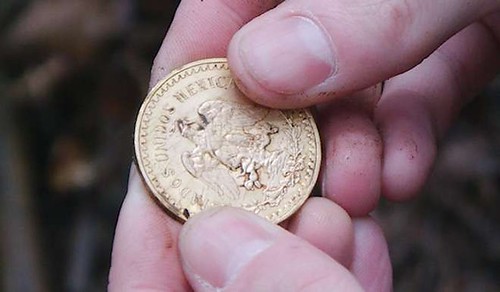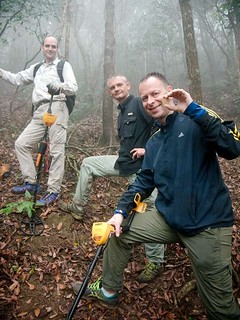
PREV ARTICLE
NEXT ARTICLE
FULL ISSUE
PREV FULL ISSUE
DETECTORISTS FIND HONG KONG PLANE CRASH COINThis article from the South China Morning Post describes a group of metal detectorists and their quest to discover lost gold at the site of the 1947 crash of a plane carrying
millions in mexican gold coins and bullion. -Editor
 Seventy years after a Philippine Airlines plane burst into flames on impact with Mount Parker, three local history buffs have unearthed a gold coin from the crash site – and with it a forgotten mystery. The upper slopes are shrouded in dense mist and low cloud on a chilly, overcast Saturday, much as they were on that afternoon seven decades ago, as three men make the arduous trek up the steep Mount Parker Trail towards the summit, metal detectors slung over their shoulders. There was no concrete trail in 1947 and newspapers at the time reported that the police search and recovery team, dispatched from Shau Kei Wan the following morning, had to cling to shrubs and tufts of grass in order to reach the smouldering crash site, where the charred remains of the four crew members were discovered. The aircraft – a Dakota bearing the registration PI-C12 – had crashed on Saturday, January 25, en route to Kai Tak airfield carrying a reported US$15 million cargo of Mexican bullion and coins, destined for seven Hong Kong banks. A significant amount of that cargo remains unaccounted for. Mitchell located the crash site by assiduously correlating the crash reports with aerial photography and press cuttings from the time and comparing them with contemporary maps. He says he has visited the site with colleagues between six and eight times, with metal detectors, but has found only small fragments of wreckage and a broken cabin clock. The impact explosion was so intense that gold coins had melted and become fused to the airframe while the force of the blast projected others across the slopes in a shower of Mexican gold pieces. “It is believed that some of the heavy gold bars thrown high into the air by the explosion may still lie deeply embedded in the soft soil of the hillside,” reported the China Mail, two days after the crash. The plane was originally reported as having plunged into the sea, in the vicinity of Junk Bay, though Mitchell suspects this was a ruse by the authorities to keep bounty hunters away from the real crash site. “The explosion must have been clearly visible to residents around Chai Wan even in bad weather,” he says.
Sommerville is the newest member of the local history group and has been out on only half a dozen expeditions. Searching further down the slope from his colleagues, his detector emits an unenthusiastic low-frequency buzz, which he dismisses as a piece of debris. Nevertheless, he agrees to pose for a photograph as he digs down into the soft soil. Instead of debris, though, he finds, about 6cm to 7cm beneath the surface, a dull yellow circular object near to the roots of a tree. He aims his “pin-pointer” (a small pencil-shaped metal detector) at it but no metallic signal is generated and he shrugs his shoulders; on a previous search, some of the group scattered chocolate coins to trick the novice into thinking there was “gold in them there hills” and he does not intend to be fooled again. Then Sommerville realises his device is switched off. He flicks the switch and the detector makes a deafening high-pitched whine every time it passes over the yellow disk. His face drains of colour as he calls out for Mitchell and Woods, who come sliding down to the scene. He brushes away brown earth and reveals the unmistakable markings of a 1946 Mexican 50-peso piece, made from 1.2 ounces of pure gold. There is a stunned silence and a brief celebratory photograph before a quick smartphone search reveals the coin is valued at about US$1,200. An intense exploration of the vicinity follows, but, after three hours, nothing else is found except a small twisted bundle of burned copper wire. One coin accounts for only a fraction of the missing gold but not all things are quantified in dollars; Sommerville has no intention of cashing in on his good fortune. “There is no way I would ever sell this,” he says. “It’s part of Hong Kong’s history.” To read the complete article, see: Wayne Homren, Editor The Numismatic Bibliomania Society is a non-profit organization promoting numismatic literature. See our web site at coinbooks.org. To submit items for publication in The E-Sylum, write to the Editor at this address: whomren@gmail.com To subscribe go to: https://my.binhost.com/lists/listinfo/esylum All Rights Reserved. NBS Home Page Contact the NBS webmaster 
|
